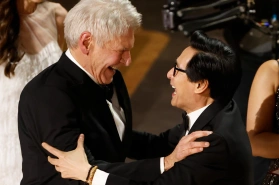
Motion pictures set directly to songs or scored music are one of the most essential forms of media creation, from early silent films to the emergence of shorts crafted to pop songs that fed into the rise of MTV . Music videos remain one of the most popular and accessible modes of creation for young media creators. (And check out earlier posts such as those about Michel Gondry or Stromae or Janelle Monáe.)
Well, in a first for the Academy Awards, the Best Director award has gone to a pair of filmmakers who first emerged as music video directors. Daniel Kwan and Daniel Scheinert – or The Daniels – won Oscars for screenwriting, directing, and Best Picture for Everything Everywhere All at Once this past Sunday night, and it is very instructive to check out their earlier work to recognize the stylistic approaches in their music videos as they relate to the visual communication, storytelling techniques, and directorial touches in their award-winning feature film. While a number of their most notable and infamous videos are not typically appropriate for in-school viewing, here are some recommended ones: Houdini and Don’t Stop by Foster the People, Simple Math by Manchester Orchestra, or Simple Song by The Shins. And as a final note about this pair: viewing their acceptance speeches in media classrooms can provide some nice inspiration for students — and for teachers too, with the heartfelt thanks by Daniel Scheinert. Certainly very appreciated.

As was pointed out a number of times during their speeches, these awards were the result of work by many people, and there were a number of other winners for this movie up on that stage, including actors Michelle Yeoh, Jamie Lee Curtis, and Ke Huy Quan and editor Paul Rodgers. As a final note, Harrison Ford giving the award for Best Picture was quite the touch on a night of many heartfelt moments.


 Meanwhile, for most of the general public, the categories for the short films are the most unknown quantities on the Oscar ballot.
Meanwhile, for most of the general public, the categories for the short films are the most unknown quantities on the Oscar ballot. 
